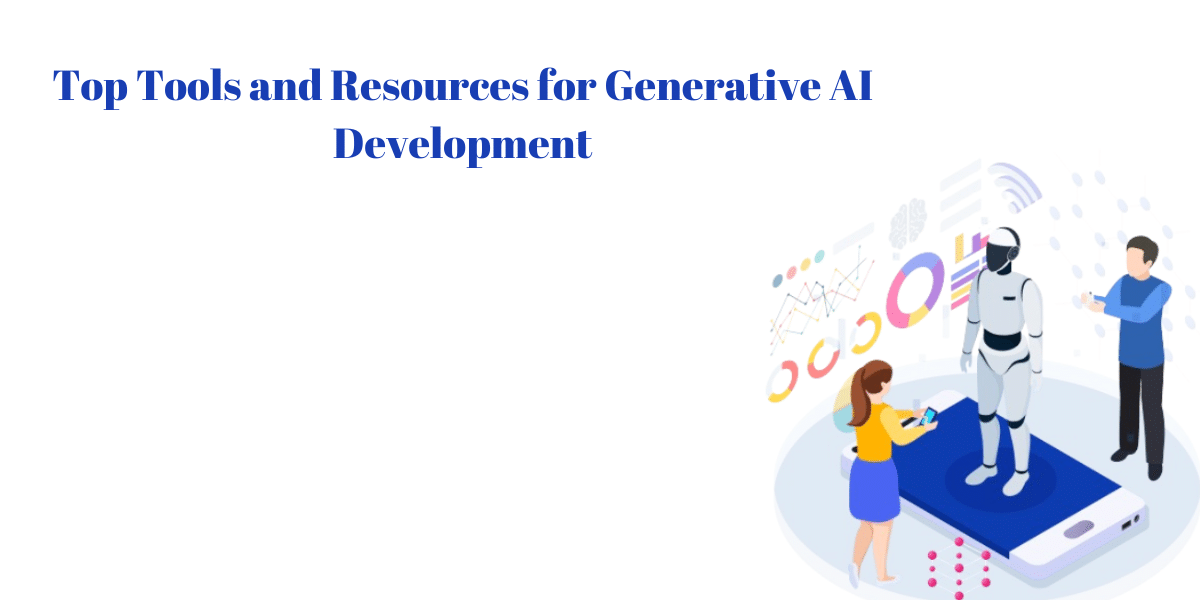Generative AI development is emerging as an innovative field offering new ways of creating media, pictures, and human-like conversation. When developers begin to explore the exciting world of Generative AI, access to the best resources and tools becomes essential to unleashing the creative power and pushing the boundaries of technology.
One of the most popular tools is TensorFlow, Google’s free-of-cost machine-learning platform. Its vast library offers tools for creating generational models like Variational Autoencoders (VAEs) and Generative Adversarial Networks (GANs). PyTorch is another well-known framework that offers dynamic computational graphs and easy integration into Python and Python, which is an ideal choice for numerous Generative AI creators.
If you are looking for an intuitive interface and speedy prototyping, platforms such as Runway ML and DeepArt.io offer an intuitive environment where designers can play around with trained models or create their own with simple procedures.
Furthermore, access to complete tutorials, documentation, and online communities dramatically improves the learning process. Sites such as Papers With Code and Distill.pub contain cutting-edge research papers, programming codes, and interactive posts, helping to facilitate the sharing of knowledge and encouraging collaboration between developers.
When it comes to generative AI development, firms have a major role to play in promoting innovation and commercialization. Top innovative generative AI companies like OpenAI, NVIDIA, and DeepMind not only contribute to the growth of this field with innovative research but also offer tools, APIs, and libraries that allow developers to build advanced intelligent models.
Exploring Top Tools and Resources for Generative AI Development
The best instruments and tools are designed specifically to support generative AI development.
TensorFlow
TensorFlow, an open-source machine-learning framework designed by Google, is still a keystone to generative AI development. Its flexibility and capacity make it ideal for creating and training various generative models, including GANs, generative adversarial networks (GANs), and variable autoencoders (VAEs). TensorFlow provides high-level APIs such as Keras, which make it easier to develop the process and provide comprehensive documentation and support for the community.
PyTorch
PyTorch, another popular framework, is now gaining popularity with developers of generative AI developers because of its flexible computation graph and intuitive user interface. Created through Facebook, PyTorch facilitates experimentation using complex neural structures and is perfect for the development of models that generate. The seamless integration of Python and its extensive collection of modules allows the developers to investigate new methods for generative AI development.
GPT OpenAI
GPT OpenAI’s pre-trained Transformer (GPT) series marks a significant breakthrough in the field of natural language processing as well as the generation of text. GPT models, based on vast amounts of text, demonstrate excellent proficiency in creating consistent and relevant texts. Designers can use already-trained GPT models or refine their performance using domain-specific data sets that allow for various applications, including content-generation dialog systems and language translators.
StyleGAN
The StyleGAN framework from NVIDIA has transformed the world of image creation by enabling stunning, high-quality photos. StyleGAN uses a progressive growth mechanism and adaptable instance normalization to produce images of unprecedented quality and variety. With a wealth of documentation and trained models, designers can investigate various artistic and innovative techniques for image synthesizing.
The Hugging Face
Transformers Hugging Face Transformers library comes with a broad range of models that have been trained and tools to process natural language. From the generation of text and summary to sentiment analysis and translators for languages, Transformers empowers developers to create sophisticated models generative of little effort. Its intuitive interface and large model zoo facilitate rapid prototyping and experiments for Generative AI development.
Unity ML-Agent
The ML-Agents Toolkit, is a machine-learning toolkit that integrates with Unity’s game development tool and allows for creating immersive, interactive experiences that AI powers. The developers can use ML agents to create generative systems that can learn and change in real-time according to the user’s behavior and open up new opportunities in the procedural generation of content and interactive storytelling.
Weights and Biases
The Weights and Biases platform provides comprehensive tools for tracking experiments, visualization, collaboration, and tracking of machine learning-related projects. It integrates with well-known frameworks and libraries like TensorFlow and PyTorch. Developers can monitor modeling performance, analyze training dynamics, and then iterate faster when working with dynamic AI process workflows for development.
Resources for Generative AI Developers
Apart from the frameworks and tools, an abundance of sources is available to assist AI developers who are generative AI developers on their path:
The Research Papers and Publications section
Keep up-to-date with the most recent developments in the field of generative AI by reading conferences, research papers, and academic papers from renowned conferences like NeurIPS, ICML, and CVPR.
Forums and online Communities
Meet like-minded researchers, developers, and practitioners through online forums and communities dedicated to the field of generative AI, such as Reddit’s r/Machine Learning or OpenAI’s forum.
Online courses and Tutorials
Utilize online tutorials, classes, and education platforms like Coursera, Udacity, and Fast.ai to increase your knowledge of generative models and their applications.
GitHub Code Samples and Repositories Discover GitHub repository sites and code samples for the latest dynamic models, experiment scripts, and reused components to use in your work.
Path to Becoming a Generative AI Developer
This article explores how individuals who are interested in learning can begin the process of becoming proficient in generative AI creation.
Foundation in AI and Machine Learning
The first step in becoming a predictive AI developer is establishing solid foundations within AI and machine learning (ML). It involves mastering programming languages such as Python, understanding the fundamental principles that are essential to ML algorithms, and examining software like TensorFlow and PyTorch, which are crucial in creating models that can be generated.
Mastering Deep Learning
Deep learning is the pillar of generative AI development. Anyone who wants to develop AI must dive into neural networks and learn about various architectures, such as activation functions, optimization methods, and regularization techniques. Knowing the intricacies of convolutional neural networks (CNN) and Recurrent neural networks (RNNs) and their variants will provide the foundation for developing complex model-based generative algorithms.
Exploring Generative Models
If you have a good understanding of deep learning, you can explore various generative models and their applications. This involves learning about GANs, which match two neural networks against one with a generator and a discriminator to create authentic outputs. In addition, those who want to develop their skills could explore VAEs focused on learning representations that are latent to information and transformers. They are well-known for their efficacy in sequence modeling.
Hands-on Practice
The mere study of theory is not enough to master the process of generative AI development. Practice is essential for developing abilities and learning from practical experiences. Future developers must be involved with projects that require building and fine-tuning generative models that span different areas. Exploring, testing, and testing models leads to knowledge of their strengths and limitations.
Leveraging Open-Source Resources
The community of open-source developers provides a wealth of tools, frameworks, and pre-trained models to aid in generative AI development. Platforms such as GitHub, Kaggle, and TensorFlow Hub allow developers to access code repositories, data sets, and instructional videos created by experts from all over the world. Participating in open-source projects can help improve one’s peers’ skills and encourage the sharing of knowledge and collaboration among the communities.
Continuous Learning and Exploration
Generative AI is a fast-growing area marked by continuous studies, innovation, and advancements. Therefore, constant studying and experimenting are vital to staying abreast of recent advances. This includes reading research articles, attending conferences, engaging in online forums, and registering for courses covering advanced topics related to the field of generative AI.
Collaboration and Networking
Networking and collaboration are essential components of professional advancement in Generative AI. Interacting with mentors, peers, and industry experts facilitates knowledge sharing, gives invaluable feedback, and can open doors to fresh possibilities. Meetups, online communities, and conferences provide ways to connect with similar individuals and establish meaningful relationships in the AI community.
Ethical Considerations
Amid all the excitement about technology that generates AI, developers need to be aware of the ethical issues and social implications of their jobs. AI technology creators are burdened with maintaining the fairness, transparency, and accountability of their designs and software. Adhering to ethical standards and encouraging accountable AI techniques is crucial to creating trust and reducing risk.
Conclusion
The ecosystem of generative AI development is enhanced by numerous tools and resources, allowing designers to design new and innovative ideas across various fields. These instruments, ranging from deep learning-based frameworks such as TensorFlow and PyTorch to libraries specializing in areas like OpenAI’s GPT and GPT, offer a solid basis for exploring and developing generative AI models. In addition, online communities, forums, and tutorials encourage sharing information and expertise with developers. This facilitates continual development and learning.
Being aware of new technologies and best practices is crucial for generative AI developers. Utilizing tools like NVIDIA’s CUDA platform for faster computing and cloud-based solutions like Google Cloud AI Platform can improve development workflows and scaling. Additionally, using pre-trained models and data sets speeds up development and experimentation, allowing rapid refinement and iteration of generative AI applications.
The need for intelligent AI solutions continues to grow, and the importance of generative AI development firms is becoming more critical. These firms act as catalysts of innovation by providing specialized knowledge and customized solutions for clients’ diverse needs. Utilizing the most cutting-edge technology and technology, the generative AI development firms drive advances in areas like health, creative arts, robotics, and healthcare, defining how AI will drive future technology.











